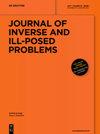全纯浸没条件下由dn -映射确定黎曼曲面的稳定性
IF 0.9
4区 数学
Q2 MATHEMATICS
引用次数: 0
摘要
本文章由计算机程序翻译,如有差异,请以英文原文为准。
Stability of determination of Riemann surface from its DN-map in terms of holomorphic immersions
Abstract Suppose that ( M , g ) {(M,g)} is a compact Riemann surface with metric g and boundary ∂ M {\partial M} , and Λ is its DN-map. Let M ′ {M^{\prime}} be diffeomorphic to M, let ∂ M = ∂ M ′ {\partial M=\partial M^{\prime}} and let Λ ′ {\Lambda^{\prime}} be the DN-map of ( M ′ , g ′ ) {(M^{\prime},g^{\prime})} . Put ( M ′ , g ′ ) ∈ 𝕄 t {(M^{\prime},g^{\prime})\in\mathbb{M}_{t}} if ∥ Λ ′ - Λ ∥ H 1 ( ∂ M ) → L 2 ( ∂ M ) ⩽ t {\lVert\Lambda^{\prime}-\Lambda\rVert_{H^{1}(\partial M)\to L^{2}(\partial M)}% \leqslant t} holds. We show that, for any holomorphic immersion ℰ : M → ℂ n {\mathscr{E}:M\to\mathbb{C}^{n}} ( n ⩾ 1 {n\geqslant 1} ), the relation sup M ′ ∈ 𝕄 t inf ℰ ′ d H ( ℰ ′ ( M ′ ) , ℰ ( M ) ) → t → 0 0 \sup_{M^{\prime}\in\mathbb{M}_{t}}\inf_{\mathscr{E}^{\prime}}d_{H}(\mathscr{E}% ^{\prime}(M^{\prime}),\mathscr{E}(M))\xrightarrow{t\to 0}0 holds, where d H {d_{H}} is the Hausdorff distance in ℂ n {\mathbb{C}^{n}} and the infimum is taken over all holomorphic immersions ℰ ′ : M ′ ↦ ℂ n {\mathscr{E}^{\prime}:M^{\prime}\mapsto\mathbb{C}^{n}} . As it is known, Λ determines not the surface ( M , g ) {(M,g)} but its conformal class { ( M , ρ g ) ∣ ρ > 0 , ρ | ∂ M = 1 } , \bigl{\{}(M,\rho g)\mid\rho>0,\,\rho|_{\partial M}=1\bigr{\}}, while holomorphic immersions are determined by this class. In the mean time, ( M , g ) {(M,g)} is conformally equivalent to ℰ ( M ) {\mathscr{E}(M)} , and ( M ′ , g ′ ) {(M^{\prime},g^{\prime})} is conformally equivalent to ℰ ′ ( M ′ ) {\mathscr{E}^{\prime}(M^{\prime})} . Thus, the closeness of the surfaces ℰ ′ ( M ′ ) {\mathscr{E}^{\prime}(M^{\prime})} and ℰ ( M ) {\mathscr{E}(M)} in ℂ n {\mathbb{C}^{n}} reflects the closeness of the corresponding conformal classes for close DN-maps.
求助全文
通过发布文献求助,成功后即可免费获取论文全文。
去求助
来源期刊

Journal of Inverse and Ill-Posed Problems
MATHEMATICS, APPLIED-MATHEMATICS
CiteScore
2.60
自引率
9.10%
发文量
48
审稿时长
>12 weeks
期刊介绍:
This journal aims to present original articles on the theory, numerics and applications of inverse and ill-posed problems. These inverse and ill-posed problems arise in mathematical physics and mathematical analysis, geophysics, acoustics, electrodynamics, tomography, medicine, ecology, financial mathematics etc. Articles on the construction and justification of new numerical algorithms of inverse problem solutions are also published.
Issues of the Journal of Inverse and Ill-Posed Problems contain high quality papers which have an innovative approach and topical interest.
The following topics are covered:
Inverse problems
existence and uniqueness theorems
stability estimates
optimization and identification problems
numerical methods
Ill-posed problems
regularization theory
operator equations
integral geometry
Applications
inverse problems in geophysics, electrodynamics and acoustics
inverse problems in ecology
inverse and ill-posed problems in medicine
mathematical problems of tomography
 求助内容:
求助内容: 应助结果提醒方式:
应助结果提醒方式:


